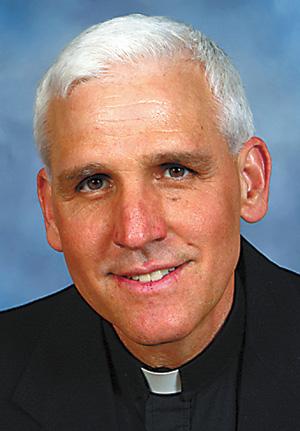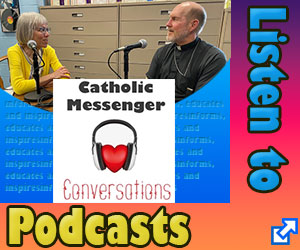
By Fr. Bill Kneemiller
What’s a wimple? Read on.
A few years ago, here in one of the Clinton County parishes, I received a call from a dad, who related a story about his 8-year-old son. He told me that his son had been watching Catholic television one Saturday morning. It happened to be an episode about a friar, who was doing a skit with puppets and teaching about Jesus.
Later that day, he and his son were collecting wood, and his son said to him: “Daddy, why aren’t we going to church anymore? I want to learn about Jesus.”
The dad said to his son: “We’re coming back — for good.”
Six months later, this family was back at church, growing in faith, and this man’s son was preparing for his first Communion.
I’m writing this article about EWTN because I know that this is not an isolated story.
I recently phoned Doug Keck, EWTN’s senior vice president of programming and production, at the network’s Alabama offices to ask him about a critique claiming that EWTN’s programming is pre-Vatican II and doesn’t empower lay people.
“A review of our programs shows that 15 of our 30 new shows feature only lay people, or a combination of lay and religious,” Keck said. “It generally comes out to 50-50 for the lay involvement.”
I asked Keck about oversight of the network. He said: “EWTN’s Board of Governors has 10 lay members and two bishops, including Bishop Robert Baker, our local ordinary, and Archbishop Charles Chaput of Denver. The network also has a working relationship with Father Lombardi of Vatican TV and radio.”
In addition, the network has featured scores of programs on Vatican II. For example, Cardinal Justin Rigali hosted a show called “The Catholic Faith and Vatican II,” and Father John Trigilio did a series called “Council of Faith: the Documents of Vatican II,” which covered every document of Vatican II.
My personal experience with EWTN
A few years ago, I thought EWTN was just a small and quaint cable show, mainly featuring Mother Angelica. After being assigned to the hinterlands of the Diocese of Davenport, I felt a need for some more priest company, even if it’s mediated via TV. So I subscribed to DISH’s family-friendly package to get EWTN.
By that time, Mother Angelica had retired after a paralyzing stroke. In her time slot is the scholarly Father Mitch Pacwa, S.J., and Father Benedict Groeschel, who is the director of the Office for Spiritual Development for the Archdiocese of New York. These two priests add great strength to EWTN’s programming.
Other highlights I’ve discovered include the children’s programs on Saturday morning and early afternoon. One show features Father Joe Kempf, who is well known in parishes for his Liguori series on baptism and reconciliation. The Saturday morning children’s films feature themes on the saints and include recent Max Lucado films. Thursday night is dedicated to young adults with “Life on the Rock” and “Backstage,” which features the best of young Catholic artists.
Another of my favorites is the “The Journey Home” program with Marcus Grodi — his show features conversion stories with Protestant ministers who have become Catholic. But my all-time favorite programs are the full-length movies on the saints. The Italian filmmakers Michele Soavi and director Carlo Carlei have produced several full- length movies on the saints that would match any American film for production quality, not to mention a superior moral message, which gets to the heart of EWTN’s mission — evangelization.
Has EWTN changed much since the days when Mother Angelica was broadcasting out of her little office? Well, it certainly has grown. The network brings the good news of Jesus Christ into 140 million homes in over 140 countries and territories. EWTN can now boast that it is the largest religious media network in the world.
The spirituality of EWTN falls into some general categories: eucharistic, with an emphasis on Mass and adoration; scriptural, featuring evangelical ministers who have become Catholic such as Scott Hahn and Jeff Cavins; social justice, with current shows such as “The Church and the Poor,” and “The Suffering Church;” and apologetics, with shows such as “The Abundant Life” with Johnnette Benkovic, and “Choices We Make” with Ralph Martin, founding director of the International Catholic Charis-matic Renewal Office.
EWTN also promotes Catholic culture. Here’s a list of some of the new shows featured in the new season, which starts in March 2009:
• Documentaries: Three original documentaries will focus on Christian persecution in Iraq.
• Men’s show: Former NFL all-pro wide receiver and coach, Danny Abramowicz, has created a show called “Crossing the Goal.” He and three co-hosts use a sports show format to encourage men to get into spiritual shape.
• Children’s programming: “The Friar,” which uses original songs, puppets, animation and live actors to convey the lessons Jesus taught in a way that will charm children and children at heart.
• Great art: EWTN was granted unprecedented access to the Vatican Museums to film “Catholic Canvas.”
• Literary masterpieces: In “The Quest for Shakespeare,” biographer Joseph Pearce investigates Shakespeare’s Catholicism using scenes from the Bard’s masterful plays.
• Popular music: Popular Irish singer Dana stars in a series, “Dana and Friends,” with her favorite Christian musicians.
• Cooking show: English journalist Joanna Bogle continues her series, “Feasts and Seasons,” featuring recipes and stories to help viewers celebrate the seasons and develop some traditions of their own.
• College show: “Catholicism on Campus: Ex Corde in Action” features Msgr. Stuart Swetland, S.T.D., a panel of university students and guest scholars who explore ways to create a richly Catholic university life.
I believe that EWTN’s greatest contribution is helping kindle Catholic culture in the home. In the culture we live in, we need “holy reminders,” we need to hear about and see movies about the saints. We need reminders of liturgical seasons and even snippets of Scripture quotes as we are rushing out the door.
EWTN has grown and matured since its humble beginnings 28 years ago, airing hundreds of different shows on Catholic themes — all with the intention of educating, entertaining and promoting our faith.
Finally, what is a “wimple?” It is a cloth wound around the head, framing the face and drawn into folds beneath the chin, worn by women in medieval times and as part of the habit of some nuns — like Mother Angelica. She certainly continues to influence the Catholic scene, even today in the twilight of her life.
(Fr. Kneemiller is pastor of Sacred Heart parishes in Lost Nation and Oxford Junction and St. James Parish in Toronto.)








